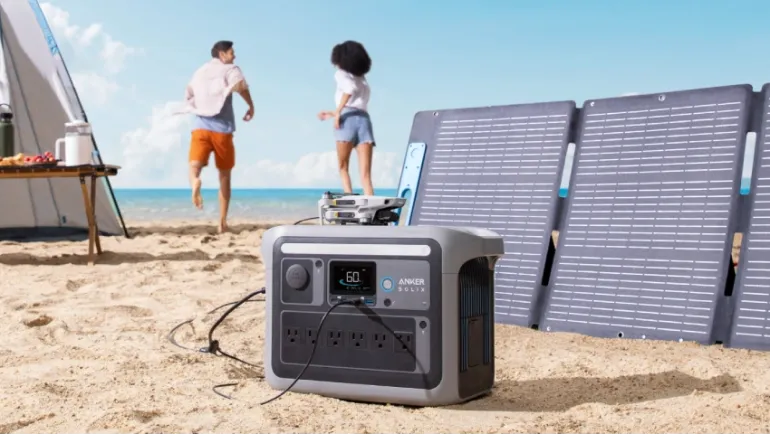When it comes to outdoor adventures or emergency preparedness, having a reliable source of power can make all the difference. Whether you’re deep in the wilderness, dealing with a blackout, or working remotely in a no-signal zone, a portable power station gives you the freedom to stay connected, charged, and safe—without being tied to the grid.
What Is a Portable Power Station?
A portable power station is essentially a large rechargeable battery housed in a compact, easy-to-carry unit. Unlike traditional gas generators, these devices run quietly, cleanly, and efficiently without fumes or fuel. Most models feature a variety of output ports, including AC outlets, USB-A/USB-C ports, and 12V car sockets, allowing you to charge phones, laptops, cameras, small appliances, and even medical devices.
They're powered either by plugging into a wall outlet or through solar panels for a fully off-grid experience.
Freedom to Explore
Imagine spending a weekend camping in the mountains without worrying about your phone dying or losing light at night. With a power station, you can charge devices, run electric coolers, or even power a small fan or LED lights—without leaving nature.
Emergency Backup
In the event of power outages, natural disasters, or emergencies, a portable power station acts as a critical backup. It can keep your phone charged to stay in contact, run a CPAP machine, or power essential electronics until the grid is back online.
Eco-Friendly and Quiet
Unlike gas-powered generators, portable stations are whisper-quiet and don’t emit any harmful fumes. This makes them perfect for use indoors, in tents, or in environments where noise and pollution matter.
Work and Travel Flexibility
For remote workers, content creators, or van-lifers, these stations offer the ability to stay productive from anywhere. Keep your laptop, camera, drone, or even a portable monitor running no matter where you are.
Key Features to Look For
When shopping for a portable power station, consider the following specs and features:
- Battery Capacity (Wh) - Measured in watt-hours, this determines how long the station can power your devices. Higher capacity (500Wh–2000Wh+) means more power for longer periods.
- Output Ports - Check for a good mix: AC outlets for standard appliances, USB ports for gadgets, and a 12V port for car-compatible devices.
- Recharge Options - Many power stations support solar panel charging. Some also allow car or USB-C PD input, giving you more flexibility to recharge on the go.
- Charging Speed - Look for fast recharging times—some newer models offer 0–80% in under an hour. This matters in emergencies or when moving between locations.
- Portability - Weight and size can vary. If you’re hiking or backpacking, opt for lightweight models (under 10 lbs). For RVs or home use, larger units are manageable.
- Smart Display or App Support - Helpful displays show input/output wattage, remaining battery life, and charge time. Some brands offer smartphone apps to control or monitor the station remotely.
Best Use Cases for Portable Power Stations
- Camping & Overlanding - Perfect for charging lanterns, GoPros, phones, or even electric grills. You get convenience without sacrificing the outdoor vibe.
- Home Emergency Backup - Keep your internet router, phone, and essential devices running during a blackout. Some larger stations can also support mini-fridges or medical equipment.
- Van Life & RV Living - A must-have for nomads. You can run induction cooktops, laptops, fans, and more—without needing to plug into campgrounds or burn fuel.
- Content Creation On-the-Go - Drones, DSLRs, lighting rigs—all need power. With a portable station, you can shoot, edit, and upload from anywhere.
- Remote Work - Say goodbye to battery anxiety on work trips, beach setups, or weekend cabins. A portable power station turns any location into your office.
Tips for Getting the Most Out of Your Power Station
- Match the capacity to your needs. Don’t overpay for power you won’t use. For phones and small gear, 300–500Wh is usually enough.
- Charge before you go. Always top up your battery before leaving for a trip or storm season.
- Invest in solar panels. They expand your charging options and help you stay powered longer.
- Use energy-efficient gear. LED lights, low-watt appliances, and smart devices will stretch your power station's life.
- Store it properly. Keep it in a cool, dry place and recharge it every few months to maintain battery health.
Conclusion: Power Up Your Next Adventure
A portable power station is more than just a fancy battery—it's your freedom pass to explore without limits. Whether you're chasing sunsets in the desert, weathering a storm at home, or editing videos on a mountain trail, having reliable, quiet, and clean power at your fingertips changes everything.
Don’t wait for a blackout or your next camping trip to realize how useful it is. Find a model that fits your lifestyle, and start powering your adventures—anytime, anywhere.













Comments
There are no comments for this Article.